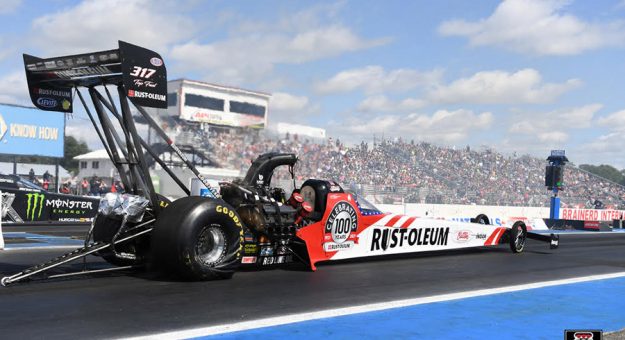Pat Dakin, whose sharp skills belie the fact he turned 75 years old in February, is like Zizzo.
The Dayton, Ohio-area businessman said a high level of competitiveness “is all in preparation. The big-dollar guys can’t prepare any better than we do. We’ve got a lot of time to prepare. We’ll go out and try to ruin their day.”
He said the fields consist of “generally the same players, and 90 percent of the time it’s the same winners, the more corporate, high-dollar people.” Dakin said he’s there to “ruin their day. There’s nothing that I like better than taking one of the big dogs out.”
Jim Maroney, a Top Fuel driver from Gilbert, Ariz., sees no advantage for part-timers other than saving money.
“As you can tell by recent car counts, there are fewer full-time teams than ever. Without the part-time racers, the (16-car) fields would probably be down to eight cars,” he said. “When it takes $2 million to $3 million a year to campaign a full-time team, without corporate involvement, most people can’t do it. This is the exact reason we are a part-time team. My team is funded though my company, American Flowtech. Bottom line is when funds are down, we don’t race.
“There seems to be a trend of ‘new’ part-time racers, most of which I believe are people that might have a dollar and want to fulfill that lifetime dream. I can’t blame anyone for doing it. I did the same thing with Terry Haddock. Fortunately, or unfortunately, I got the bug really bad and decided to take a stab at doing it on my own. I think you’ll see that trend grow, and I think it’s good for the sport. Hopefully, these part-time teams will be able to step up and run competitive numbers. Everyone wants to root for the underdog,” Maroney said.
For Funny Car part-timer Alex Miladinovich, being an ambassador for drag racing is much of the reward.
“I can do what the big teams can’t: getting back to being personable. When we’re done working and there’s nothing going on, (the crew members) have explicit instructions: If there’s a family there, invite them in, let them take pictures and give them their money’s worth,” he said. “I’m still a huge race fan. The experience that I was given to have a good time at the drags, if I can pass that along to the next race fan, you’re going to get your money’s worth if you come by and see me.”
Maroney hit on a couple of drawbacks of racing part time.
“It’s difficult to get that Top Fuel adrenaline rush, then have to shelve that thrill for months,” he said. “It’s very hard. I’m a racer. I’ll race just about anything. In a perfect world, I’d be able to compete full time, but I can’t. So I have to fill the void with other venues. In our house, we work hard and play even harder. In addition to the Top Fuel dragster, I have three other drag cars, a non-winged sprint car and three boats. I think it’s harder on my crew. They are all volunteer and it’s hard to stay motivated to spend time at the shop prepping for the next event when it’s months away.”
As a youngster in Salt Lake City, Rob Passey gathered used soda pop bottles and returned them to stores to collect the deposit. Passey wanted the change he’d earn to buy the latest issue of drag-racing magazines. He’d gaze at those pages and daydream that someday he would be like those dashing, daring men on the pages. As he grew up, he kept his dream tucked in his heart and went about making a living. And just like when he was 10, he saved his money to spend on drag racing. Now, he’s a part-time Top Fuel racer.
“We’ve got probably what everybody else has, except we don’t have the latest, greatest, state-of-the-art clutch programs, and I don’t have a $25,000 supercharger. But other than those two things, I think we’re on par with everybody,” he said. “We know we don’t have the finances to go knock heads, but we can get in the show and then it’s anybody’s guess from there. You never know. We’ll keep beating on this thing and see what happens.”
